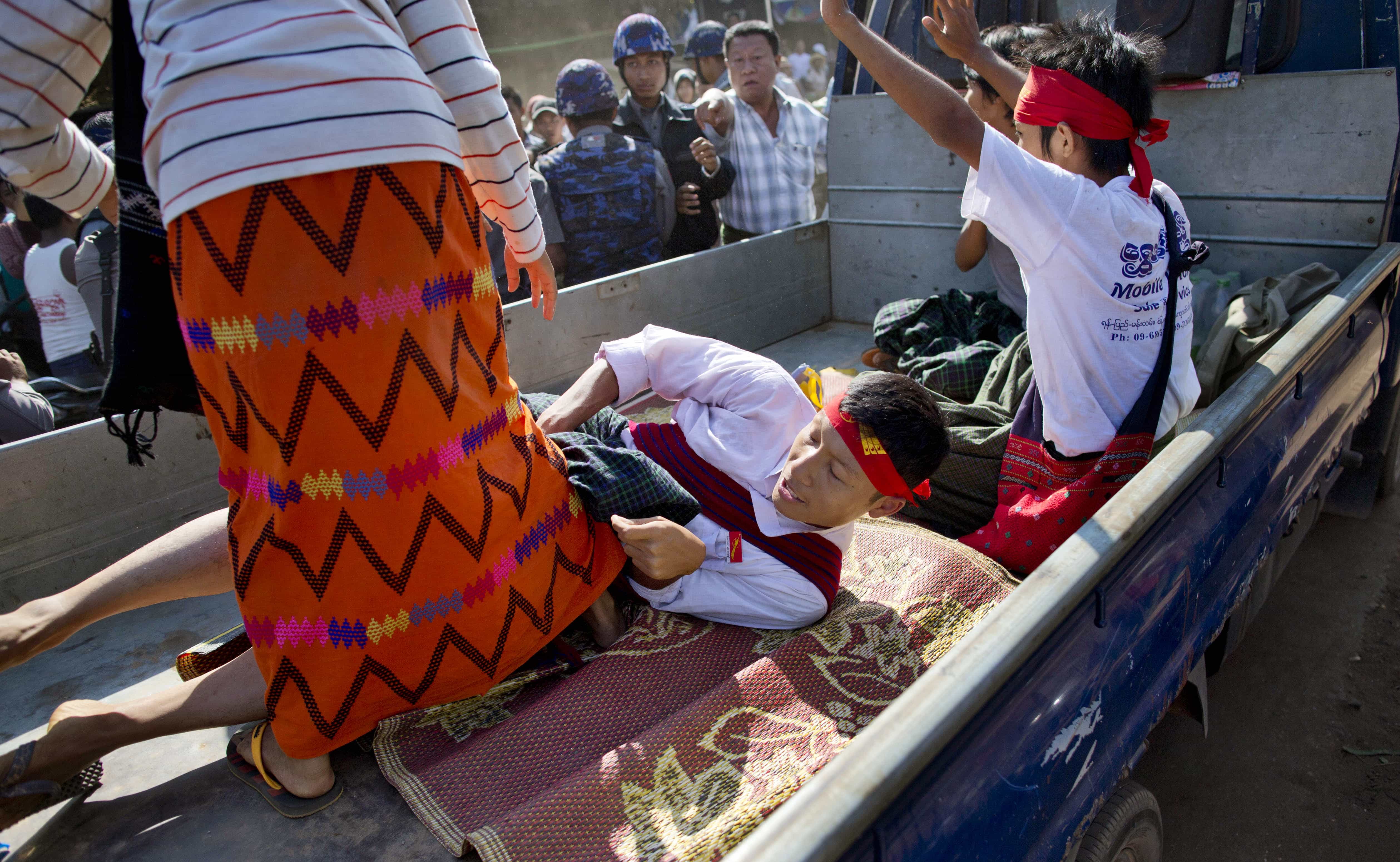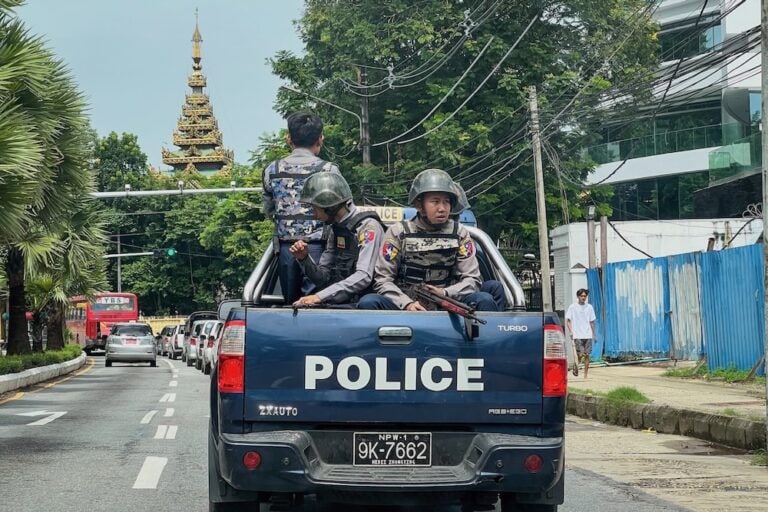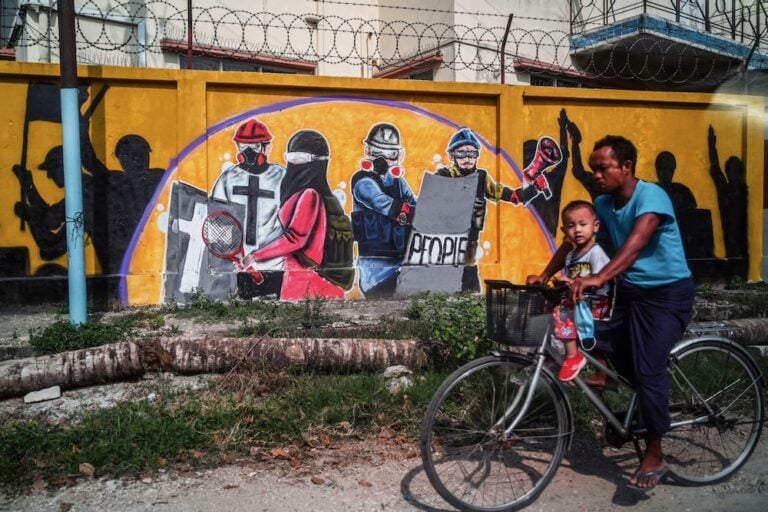Burmese security police and civilians wearing red armbands attacked activists and students protesting outside Yangon City Hall and arrested eight in a surge in tension over spreading student rallies calling for education reform.
This statement was originally published on mizzima.com on 6 March 2015.
Security police and civilians wearing red armbands attacked activists and students protesting outside Yangon City Hall and arrested eight in a surge in tension over spreading student rallies calling for education reform.
Over 100 police and civilians wearing red armbands attacked about 50 protestors including members of the 88-Generation Peace and Open Society and students with batons at 4 pm on March 5.
Dozens of demonstrators were sent scattering after they were violently set upon.
The activists staged the protest outside Yangon City Hall in support of students in Letpadan opposed to the National Education Law who have been blocked by the police from continuing their march to Yangon.
At about 3:30 pm, before the protestors arrived outside Yangon City Hall, the Kyauktada Township general administrative chief came to the venue and announced that the illegal assembly would not be allowed.
After the protestors began arriving, the general administrative chief ordered them to disperse and if they failed to obey the order, the authorities will use Section 127/128 of the law to disperse the crowd. Then, within 30 minutes, police and civilians wearing red armbands attacked the protestors and arrested eight protestors.
“I was quite scared. A policeman hit me with a baton, he was aiming for my head but he hit only my arms” said 17-year-old student Ma Su Yin Lin on the sidelines of a hastily arranged press conference by activists on the evening on March 5.
“He hit me once and then another student pulled me away,” she added, her left arm bearing visible bruising.
Ma Ei Swe Myat, a protestor who is a chairperson of Yangon University Students Union, said: “As far as I know, eight protestors were arrested. But I don’t know exactly. The violent crackdown shows their attitude towards students. Are they really willing to amend the National Education Law? They launched a violent crackdown against peaceful protest. So they should solve the problem.”
Ko Aung Kyaw, a student from the Ayeyarwady students’ column, said: “We hoped that they would implement the results obtained in the four-party group as soon as possible and the demands would be completed peacefully.”
But we did not expect a violent crackdown, he said.
“I would like to tell authorities not to commit violence against student protestors. If they launch a violent crackdown, it means a violating of democratic principles. We will peacefully demonstrate to get our demands,” he said.
A government spokesperson sought to distance the central government from the violence.
U Ye Htut, the spokesperson for the President, said that the action of the civilians wearing red armbands was only an arrangement made by the Yangon Region authorities.
“The regional government [organized this]. It was not done by the Union government [central government],” he said.
According to the 1945 Police Act, civilians from nearby areas can be appointed as reserve policemen to crush unrest, and like the real police, the people who are appointed as reserve police have the power to arrest and detain people from the relevant area.
The Police Act says that even plain-clothes police can be posted in order to control the situation and unrest.
The rally saw about 50 protesters gather in the heart of Yangon, Myanmar’s main commercial hub, in solidarity with a student demonstration in the central town of Letpadan, where around 200 activists have been corralled by riot police since March 2.
Authorities have expressed determination to stop that group from continuing their planned march to Yangon, the site of several mass student demonstrations in Myanmar’s modern history that have convulsed the country.
“We will definitely respond with another movement,” said student leader Ko Min Thu Kyaw, who was at the Yangon protest. But he said the group would wait to see how the government would proceed.
Ko Min Ko Naing, leader of the 88 Generation democracy campaign group, held up a printout at the press conference of a photograph from the crackdown showing a young female protester being held by the neck by a man in an armband.
“Are they showing the brutality of this era?” asked the veteran of mass student-led rallies nearly three decades ago that rocked Myanmar’s then military government.
“We cannot tolerate this at all,” he said.
Those sporting red arm bands had the word for “Duty” emblazoned on them.
Police at the scene earlier confirmed that seven people were arrested, but the government has yet to make an official comment on the crackdown.
Student activism is a potent political force in Myanmar with young campaigners at the forefront of several major uprisings, including a huge 1988 demonstration that prompted a bloody military assault under the former junta.
The 88 Generation is made up largely of student activists from that mass protest, which also saw the rise of Daw Aung San Suu Kyi’s opposition.
Until now the authorities had appeared reluctant to take forceful action against the months-long student protests, despite the activists holding their demonstrations without permission.
Tensions have risen since March 3 when students in Letpadan ignored a deadline from authorities to disperse and give up plans of marching to Yangon, some 130 kilometres [80 miles] further south.
The students have rallied for months against education legislation, calling for changes to the new law including decentralising the school system, giving students the right to form unions and teaching in ethnic minority languages.
Talks between the government and the young activists had led to a rethink of the legislation by parliament, which is currently debating proposed changes.
But students earlier on March 5 told MPs they were pulling out of the discussions because of police efforts to stop the Letpadan activists from going to Yangon.
Additional reporting by AFP



